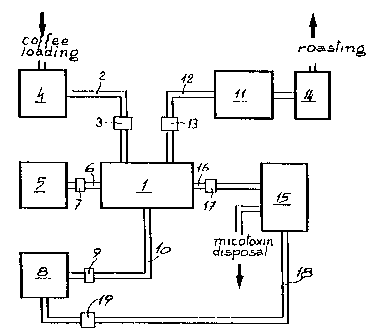Une partie des informations de ce site Web a été fournie par des sources externes. Le gouvernement du Canada n'assume aucune responsabilité concernant la précision, l'actualité ou la fiabilité des informations fournies par les sources externes. Les utilisateurs qui désirent employer cette information devraient consulter directement la source des informations. Le contenu fourni par les sources externes n'est pas assujetti aux exigences sur les langues officielles, la protection des renseignements personnels et l'accessibilité.
L'apparition de différences dans le texte et l'image des Revendications et de l'Abrégé dépend du moment auquel le document est publié. Les textes des Revendications et de l'Abrégé sont affichés :
| (12) Brevet: | (11) CA 2254752 |
|---|---|
| (54) Titre français: | PROCEDE POUR ENLEVER LES MICOTOXINES D'UNE CHARGE DE CAFE VERT |
| (54) Titre anglais: | A PROCESS TO REMOVE MICOTOXINS FROM A LOAD OF GREEN COFFEE |
| Statut: | Durée expirée - au-delà du délai suivant l'octroi |
| (51) Classification internationale des brevets (CIB): |
|
|---|---|
| (72) Inventeurs : |
|
| (73) Titulaires : |
|
| (71) Demandeurs : |
|
| (74) Agent: | SMART & BIGGAR LP |
| (74) Co-agent: | |
| (45) Délivré: | 2004-08-24 |
| (86) Date de dépôt PCT: | 1997-04-22 |
| (87) Mise à la disponibilité du public: | 1997-11-20 |
| Requête d'examen: | 2002-02-15 |
| Licence disponible: | S.O. |
| Cédé au domaine public: | S.O. |
| (25) Langue des documents déposés: | Anglais |
| Traité de coopération en matière de brevets (PCT): | Oui |
|---|---|
| (86) Numéro de la demande PCT: | PCT/EP1997/002014 |
| (87) Numéro de publication internationale PCT: | WO 1997042831 |
| (85) Entrée nationale: | 1998-11-12 |
| (30) Données de priorité de la demande: | ||||||
|---|---|---|---|---|---|---|
|
Le café vert est conservé à l'état mélangé dans un récipient (1) dans lequel de la vapeur est introduite jusqu'à ce que les grains de café deviennent poreux et perméables, ce qui permet d'obtenir un solvant apte à enlever les cires de la surface desdits grains de café. Les micotoxines sont ensuite introduites et encore extraites jusqu'à ce que la quantité de micotoxines voulue ait été enlevée du café.
Green coffee is kept in a container wherein steam is introduced until the
coffee beans become porous and permeable. A solvent suited to removing
micotoxins and waxes from the surface of the coffee is introduced and
extracted
again as soon as it has removed the desired amount of micotoxins from the
coffee.
Note : Les revendications sont présentées dans la langue officielle dans laquelle elles ont été soumises.
Note : Les descriptions sont présentées dans la langue officielle dans laquelle elles ont été soumises.

2024-08-01 : Dans le cadre de la transition vers les Brevets de nouvelle génération (BNG), la base de données sur les brevets canadiens (BDBC) contient désormais un Historique d'événement plus détaillé, qui reproduit le Journal des événements de notre nouvelle solution interne.
Veuillez noter que les événements débutant par « Inactive : » se réfèrent à des événements qui ne sont plus utilisés dans notre nouvelle solution interne.
Pour une meilleure compréhension de l'état de la demande ou brevet qui figure sur cette page, la rubrique Mise en garde , et les descriptions de Brevet , Historique d'événement , Taxes périodiques et Historique des paiements devraient être consultées.
| Description | Date |
|---|---|
| Inactive : Périmé (brevet - nouvelle loi) | 2017-04-22 |
| Inactive : CIB de MCD | 2006-03-12 |
| Accordé par délivrance | 2004-08-24 |
| Inactive : Page couverture publiée | 2004-08-23 |
| Préoctroi | 2004-06-15 |
| Inactive : Taxe finale reçue | 2004-06-15 |
| Inactive : Grandeur de l'entité changée | 2004-03-18 |
| Un avis d'acceptation est envoyé | 2004-02-20 |
| Lettre envoyée | 2004-02-20 |
| Un avis d'acceptation est envoyé | 2004-02-20 |
| Inactive : Approuvée aux fins d'acceptation (AFA) | 2003-12-24 |
| Modification reçue - modification volontaire | 2003-11-10 |
| Lettre envoyée | 2002-03-25 |
| Modification reçue - modification volontaire | 2002-02-27 |
| Exigences pour une requête d'examen - jugée conforme | 2002-02-15 |
| Toutes les exigences pour l'examen - jugée conforme | 2002-02-15 |
| Requête d'examen reçue | 2002-02-15 |
| Lettre envoyée | 1999-11-23 |
| Inactive : Transfert individuel | 1999-09-21 |
| Inactive : Correspondance - Formalités | 1999-09-21 |
| Inactive : CIB en 1re position | 1999-01-25 |
| Symbole de classement modifié | 1999-01-25 |
| Inactive : CIB attribuée | 1999-01-25 |
| Inactive : Lettre de courtoisie - Preuve | 1999-01-19 |
| Inactive : Notice - Entrée phase nat. - Pas de RE | 1999-01-12 |
| Demande reçue - PCT | 1999-01-08 |
| Demande publiée (accessible au public) | 1997-11-20 |
Il n'y a pas d'historique d'abandonnement
Le dernier paiement a été reçu le 2004-02-10
Avis : Si le paiement en totalité n'a pas été reçu au plus tard à la date indiquée, une taxe supplémentaire peut être imposée, soit une des taxes suivantes :
Veuillez vous référer à la page web des taxes sur les brevets de l'OPIC pour voir tous les montants actuels des taxes.
Les titulaires actuels et antérieures au dossier sont affichés en ordre alphabétique.
| Titulaires actuels au dossier |
|---|
| DEMUS S.P.A. |
| Titulaires antérieures au dossier |
|---|
| MASSIMILIANO FABIAN |